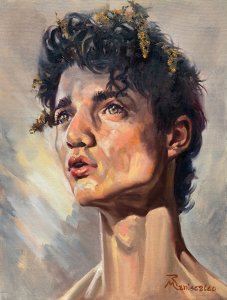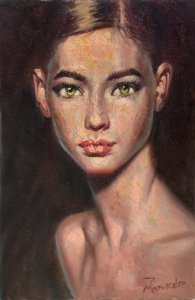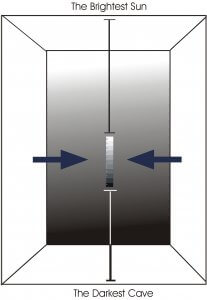Excerpt From “The Power of Positive Painting,” the Upcoming Color Book, by Robert Maniscalco
Shedding Light on Values
In the beginning, there was light. Long before Thomas Kinkaid turned “painter of light” into a ridiculous slogan, the masters knew of its critical importance in the making of a picture. Value is not as sexy as hue and chroma, so it often gets far too little attention from art teachers.
Frank Reilly began applying the Munsell System to his painting method with his students at the Art Student’s league in the 1940-60s. His life’s work was to unlock the mystery of light, by carefully analyzing how to achieve the illusion of three-dimensional form on a two-dimensional surface. He determined the easiest and most effective way to create this illusion was to understand and quantify the effect of light on form, using the Munsell System.
Of course, the effects of light on form had been observed and expressed widely by the masters for hundreds of years. But no one had ever attempted to quantify a system for understanding how values worked, before Reilly.
Some artists, after years of careful observation, come to understand values intuitively. But for most, understanding light is taken for granted. It is the unspoken language of the artist. I run into artists who have no idea how or what they are doing, yet produce many subtle, dramatic lighting effects. Unfortunately, there are far more artists who do not. It is not because they are incapable of seeing or appreciating light on form. They simply do not understand the secret of how light and form interact or its critical importance in the painting process. This leads at best to inconsistency, and at worst, an amorphic quality pervading their work, absent of a sense of light and life.
This challenge is compounded by the fact that the spectrum of value available to us in paint is quite limited. We have a relatively narrow value range with paint, from black to white. And yet we are expected to somehow find a way to express the extreme spectrum of light that exists in nature, with colored mud. The challenge is that the spectrum of value from black to white in paint is a mere fraction of the spectrum between the darkest cave and the blinding lightness of the sun, as illustrated left.
Rembrandt, one of the greatest practitioners of Chiaroscuro painting, took the use of light on form to monumental heights in achieving form, character and the deepest of human emotions, revealed through light. The Chiaroscuro school introduced the rendering of light and shade in painting, the subtle gradations and marked variations of light and shade for dramatic effect. Caravaggio and Rembrandt knew the moment light hit an object it described its form, its depth and breadth. In fact, without some deeper understanding of this play of light, it is difficult to imagine mere mortals achieving the magic of light in our work, let alone character or likeness. We are about to learn the secret to achieving that deep emotional connection the masters had with their subjects the masters and achieved in their paintings. This “play of light,” this drama, is what we long to understand.
 We all have noticed that without light, objects appear flat. What we may not have noticed is that the character of form is what produces the likeness and even the mood of our subjects. Character is illuminated by the conglomeration of unique abstract shapes, masses and forms which are interdependent, yet uniquely related to one another, through value.
We all have noticed that without light, objects appear flat. What we may not have noticed is that the character of form is what produces the likeness and even the mood of our subjects. Character is illuminated by the conglomeration of unique abstract shapes, masses and forms which are interdependent, yet uniquely related to one another, through value.
Likeness depends primarily on two things, a unified drawing, and an accurate expression of form. Light reveals form and provides the building blocks of character. Therefore, we must get a handle on values. One might go so far to say, it how light plays on form, that allows us to express our feelings about what we are painting. This lack of understanding of light on form is what prevents us from truly “capturing” our subjects, powerfully and dramatically.
We understand, intuitively, that light is important. We see how it somehow reveals our subject, whether it is a small child, a beautiful sunset, or a delicate flower. You may be struggling with value in your work and not even realize it is the problem. We are told our color is not “pure” enough or “dynamic” enough. We are too “muddy.” Trust me, 99.9% of the time, it is an issue with values. The reason is because we have not yet learned the powerful secret about value and light the masters understood very well. The power of light remains a mystery, always just out of reach. Following is the study of how light is the key to revealing life itself. . .
Read the Forward from “The Power of Positive Painting.
Read the “Background of the P3 Method”
Get “The Power of Positive Painting”
 Would you like to get inspiration in your inbox, rather than ads for more stuff? Welcome to ManiscalcoGallery.com
Would you like to get inspiration in your inbox, rather than ads for more stuff? Welcome to ManiscalcoGallery.com